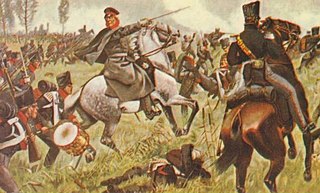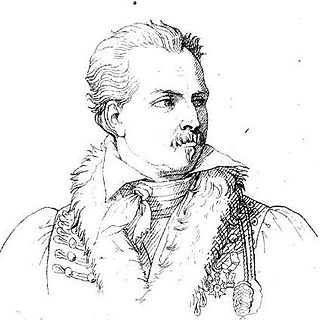Related Research Articles

The Battle of Leipzig, also known as the Battle of the Nations, was fought from 16 to 19 October 1813 at Leipzig, Saxony. The Coalition armies of Austria, Prussia, Sweden, and Russia, led by Tsar Alexander I and Karl von Schwarzenberg, decisively defeated the Grande Armée of French Emperor Napoleon Bonaparte. Napoleon's army also contained Polish and Italian troops, as well as Germans from the Confederation of the Rhine. The battle was the culmination of the German Campaign of 1813 and involved 560,000 soldiers, 2,200 artillery pieces, the expenditure of 400,000 rounds of artillery ammunition, and 133,000 casualties, making it the largest battle of the Napoleonic Wars, and the largest battle in Europe prior to World War I.

The Battle of Brienne saw an Imperial French army led by Emperor Napoleon attack Prussian and Russian forces commanded by Prussian Field Marshal Gebhard Leberecht von Blücher. After heavy fighting that went on into the night, the French seized the château, nearly capturing Blücher. However, the French were unable to dislodge the Russians from the town of Brienne-le-Château. Napoleon himself, making his first appearance on a battlefield in 1814, was also nearly captured. Very early the next morning, Blücher's troops quietly abandoned the town and retreated to the south, conceding the field to the French.

The Battle of Ulm on 16–19 October 1805 was a series of skirmishes, at the end of the Ulm Campaign, which allowed Napoleon I to trap an entire Austrian army under the command of Karl Freiherr Mack von Leiberich with minimal losses and to force its surrender near Ulm in the Electorate of Bavaria.

The Battle of La Rothière was fought on the 1st of February 1814 between the French Empire and allied army of Austria, Prussia, Russia, and German States previously allied with France. The French were led by Emperor Napoleon and the coalition army was under the command of Gebhard Leberecht von Blücher. The battle took place in severe weather conditions. The French were defeated but managed to hold until they could retreat under cover of darkness.

The Battle of Wartenburg took place on 3 October 1813 between the French IV Corps commanded by General Henri Gatien Bertrand and the Allied Army of Silesia, principally the I Corps of General Ludwig von Yorck. The battle allowed the Army of Silesia to cross the Elbe, ultimately leading to the Battle of Leipzig.
The I Corps of the Grande Armée was a French military unit that existed during the Napoleonic Wars. Though disbanded in 1814, following the Treaty of Fontainebleau, it was reformed in April 1815 following the return of Napoléon during the Hundred Days. During the Hundred Days, the corps formed part of the quickly re-formed Army of the North.

The military career of Napoleon Bonaparte spanned over 20 years. He led French armies in the French Revolutionary Wars and later, as emperor, in the Napoleonic Wars. Despite his rich war-winning record, Napoleon's military career ended in defeat. Napoleon has since been regarded as a military genius and one of the finest commanders in history. His wars and campaigns have been studied at military schools worldwide. He fought more than 80 battles, losing only eleven, mostly towards the end when the French army was not as dominant. The French dominion collapsed rapidly after the disastrous invasion of Russia in 1812. Napoleon was defeated in 1814 and exiled to the island of Elba, before returning to France. He was finally defeated in 1815 at the Waterloo. He spent his remaining days in British custody on the remote volcanic tropical island of Saint Helena.
Digby Smith was a British military historian. The son of a British career soldier, he was born in Hampshire, England, but spent several years in India and Pakistan as a child and youth. As a "boy soldier", he entered training in the British Army at the age of 16. He was later commissioned in the Royal Corps of Signals, and held several postings with the British Army of the Rhine.

Jean-Jacques Germain Pelet-Clozeau became a French general in the Napoleonic Wars and later was a politician and historian. He joined the French army in 1800 and became a topographic engineer. He joined the staff of Marshal André Masséna and was wounded at Caldiero in 1805. He served in southern Italy in 1806 and Poland in 1807. He was wounded at Ebelsberg and fought at Aspern-Essling and Wagram in 1809.

Antoine Maurin commanded a French cavalry division in 1814 during the Napoleonic Wars and in 1815 led his troops against the Prussians at Ligny where he was wounded. His army service began in 1792 during the French Revolution when he enlisted in a cavalry regiment as a trooper. He spent his entire military career as a cavalryman. During the French Revolutionary Wars he advanced through the ranks and became commander of a light cavalry regiment in 1802. While only a colonel, he commanded a brigade at Caldiero in October 1805. He fought in the Friedland campaign in 1807 and attained the rank of general officer that year. As a cavalry brigadier, he participated in the 1807 Invasion of Portugal but was captured in 1808 and held until 1812. He led a brigade in 1813 and a division in 1814 during the War of the Sixth Coalition. After fighting for Napoleon during the Hundred Days, he retired in 1823. His surname is one of the names inscribed under the Arc de Triomphe, on Column 40.
The IV Cavalry Corps of the Grande Armée was a French military unit that existed during the Napoleonic Wars. The corps was created in 1812 and rebuilt in 1813 and 1815. Emperor Napoleon I first organized the corps for the invasion of Russia. Under General Victor de Fay de La Tour-Maubourg, the corps fought at Borodino. During the War of the Sixth Coalition in 1813, General François Étienne de Kellermann commanded the all-Polish corps at Leipzig.
The V Cavalry Corps of the Grande Armée was a French military unit that existed during the Napoleonic Wars. The corps was created in 1813 and fought until 1814. Emperor Napoleon Bonaparte first organized the corps during the summer armistice in 1813 and it fought at Dresden and Leipzig. General Samuel-François Lhéritier led the corps at first but was replaced by General Pierre Claude Pajol. After Pajol was wounded at Leipzig, General Édouard Jean Baptiste Milhaud commanded the corps at Hanau in 1813 and at Brienne, La Rothière, Mormant, Fère-Champenoise, and Paris in 1814.
The VI Cavalry Corps of the Grande Armée was a French military unit that had an ephemeral existence during the Napoleonic Wars. The corps was created on 9 February 1814 and General François Étienne de Kellermann was appointed as its commander. The corps was formed by combining a newly arrived dragoon division from the Spanish front, a second dragoon division, and a light cavalry division made up of hussars and Chasseurs-à-Cheval. The latter two divisions included units from the former III Cavalry Corps. Kellermann led the VI Cavalry Corps at Mormant, Troyes, Bar-sur-Aube, Laubressel, and Saint-Dizier. After Emperor Napoleon Bonaparte abdicated in early April, the corps ceased to exist.

The Battle of Limonest saw 30,000-53,000 Austrian and Hessian troops led by Prince Frederick of Hessen-Homburg defeat 20,000-23,000 French troops under Marshal Pierre Augereau.

Pierre François Xavier Boyer became a French division commander during the Napoleonic Wars. He joined a volunteer regiment in 1792. He fought in the Italian campaign of 1796 and participated in the French invasion of Egypt in 1798. He became a general of brigade in 1801 and took part in the Expedition to Saint-Domingue in 1802. While sailing back to France he was captured by the British. After being exchanged, he fought at Jena and Pultusk in 1806, Friedland in 1807 and Wagram in 1809. Transferred to Spain, Boyer led a dragoon division at Salamanca and Battle of Venta del Pozo in 1812 and Vitoria in 1813. He earned the nickname "Pedro the Cruel" for brutal actions against Spanish partisans. He led an infantry division at the Nivelle and the Nive in late 1813. His division was transferred to the fighting near Paris and he was promoted general of division in February 1814. He led his troops at Mormant, Craonne, Laon and Arcis-sur-Aube.

Sigismond Frédéric de Berckheim became a French division commander during the last years of the Napoleonic Wars. Born into an old Alsatian family, he joined an infantry regiment at the age of 14. In 1807 he became the commanding officer of the 1st Cuirassier Regiment. In 1809 he led his cavalrymen at Eckmühl, Ratisbon, Aspern-Essling and Wagram. Promoted to general of brigade, he fought at First and Second Polotsk and the Berezina in 1812. He led a cavalry brigade at Lützen and Bautzen in 1813. Promoted to general of division, he led a cavalry division at Dresden, Leipzig and Hanau. He commanded a cavalry division at Arcis-sur-Aube in 1814. He became an inspector general and a member of the Chamber of Deputies in 1815 and 1816. His surname is one of the names inscribed under the Arc de Triomphe, on Column 12.

Pierre Decouz became a French division commander during the later Napoleonic Wars. He was born in the Kingdom of Sardinia but after the region was annexed to France, he joined a volunteer battalion in 1793. He fought in Italy during the War of the First Coalition. He participated in the French campaign in Egypt and Syria, fighting at the Pyramids, Acre and Abukir. After distinguishing himself at Austerlitz in 1805, he was promoted to command an infantry regiment. In 1806–1807 he led his regiment at Auerstädt, Pultusk and Eylau. In 1809 he fought at Eckmühl, Ratisbon and Wagram, winning promotion to general of brigade. After leading an Imperial Guard brigade at Lützen and Bautzen in 1813, he was promoted general of division. He commanded a Young Guard division at Dresden and Leipzig. Still leading a Young Guard division, he was fatally wounded at the Battle of Brienne and died three weeks later. His surname is one of the names inscribed under the Arc de Triomphe, on Column 17.
Joseph Boyer de Rébeval became a French division commander during the later Napoleonic Wars. He enlisted in the French Royal Army in 1787 and earned promotions through the ranks in the War of the First Coalition and subsequent conflicts. He was wounded at Valvasone in March 1797. He emerged as a major in the Vélites of the Imperial Guard in 1806 and fought at Kolberg in 1807. He was promoted colonel of the 2nd Foot Chasseurs of the Guard in 1808. He fought at Wagram in 1809, winning promotion to general of brigade. He was wounded at Borodino in 1812. He commanded a Young Guard brigade at Dresden and Leipzig in 1813 and was promoted to general of division. He led a Young Guard division at Craonne, where he was wounded, and at Laon, Reims and Arcis-sur-Aube in 1814. During the Hundred Days he commanded units of the Imperial Guard at Waterloo in 1815 and retired soon afterward.

François Roguet became a French division commander in the Imperial Guard during the Napoleonic Wars. He enlisted in the French Royal Army in 1789. His regiment was assigned to the Army of Italy in 1792 and fought in the Italian campaigns of the French Revolutionary Wars. He commanded a battalion at the Battle of Rivoli in 1797. He was badly wounded at the Battle of Verona in 1799. For suppressing partisans he was promoted to command an infantry regiment.
References
- 1 2 "George F(rancis) Nafziger." Contemporary Authors Online. Detroit: Gale, 2002. Literature Resource Center. Web. 26 Apr. 2011.
- ↑ George-nafziger.co.tv